In the bustling symphony of a commercial kitchen, amidst the clatter of pans and the sizzle of hot oil, In the bustling symphony of a commercial kitchen, amidst the clatter of pans and the sizzle of hot oil, there are humble components working tirelessly, often unnoticed. We’re talking about your commercial kitchen grease filters. These seemingly simple metal panels are far more critical than their appearance suggests.
Many assume “cleaning the hood” is just about wiping surfaces, overlooking the vital role and proper maintenance of these filters. When neglected, they become a dangerous bottleneck, compromising safety, efficiency, and air quality.
This guide will take you “beyond the mesh,” delving into the hidden world of commercial kitchen grease filters. We’ll explore their types, their critical function, and why understanding their role is paramount for every Sacramento restaurant owner committed to safety and operational excellence.
The Unsung Heroes: What Grease Filters Actually Do
- Primary Function: Capture airborne grease, smoke, and moisture before they enter the exhaust ductwork. They act as the first line of defense.
- Fire Prevention: By trapping grease at the entry point, filters significantly reduce the amount of flammable buildup in ducts. A core element of NFPA 96 filters compliance.
- Duct Protection: Without proper filtration, the entire exhaust system becomes saturated with grease, leading to fire risk and costly cleanings.
- Air Quality: Filters reduce particulate matter and cooking vapors, improving overall commercial kitchen air quality.
Understanding Your Filters: Types of Commercial Grease Filters
- Baffle Filters
- Angled, staggered metal baffles that force grease to condense and drain.
- Pros: Excellent at grease removal, highly durable, NFPA 96 compliant.
- Cons: Heavier than mesh.
- Mesh Filters
- Made from layered metal mesh.
- Pros: Cost-effective.
- Cons: Less effective, prone to clogging, fire hazard, not NFPA 96 compliant in many kitchens.
- Specialized Filters
- Charcoal filters (odor control), UV-C systems (break down grease/pathogens).
- Always used in combination with baffle filters.
The Impact of Neglected Filters: Warning Signs & Risks
- Increased Fire Risk: Grease-saturated filters are a direct ignition hazard.
- Reduced Ventilation: Dirty filters choke airflow, trapping smoke and heat.
- Fan Strain: Exhaust fans must work harder, leading to energy waste and early breakdown.
- Compliance Violations: Dirty or incorrect filters are a red flag for health inspectors and fire marshals.
- Pest Attraction: Grease buildup attracts insects and rodents, degrading kitchen hygiene.
Beyond Daily Wipes: Professional Filter Maintenance
- Daily Cleaning (Staff): Remove and degrease filters daily. Essential, but not sufficient.
- Professional Filter Exchange Services:
- Thorough degreasing and inspection
- Filter assessment and replacement advice
- Cleaning of the plenum and ductwork
- Full NFPA 96 compliance
- Program offered exclusively through Elite Pressure Pros
- Integrated Approach: Filter cleaning is just one part of a full-service commercial hood cleaning strategy, included with The Hood Standard — our all-inclusive plan for safety, scheduling, and peace of mind.
Conclusion
Your commercial kitchen grease filters are small, but mighty. They’re your first line of defense against fire hazards, poor air quality, and expensive repairs. Understanding their types, maintaining them properly, and partnering with a trusted team is essential.
Don’t let these unsung heroes become a weak link in your operation. Contact Elite Pressure Pros today for complete commercial hood cleaning and expert filter care that keeps your Sacramento kitchen safe, clean, and compliant.

